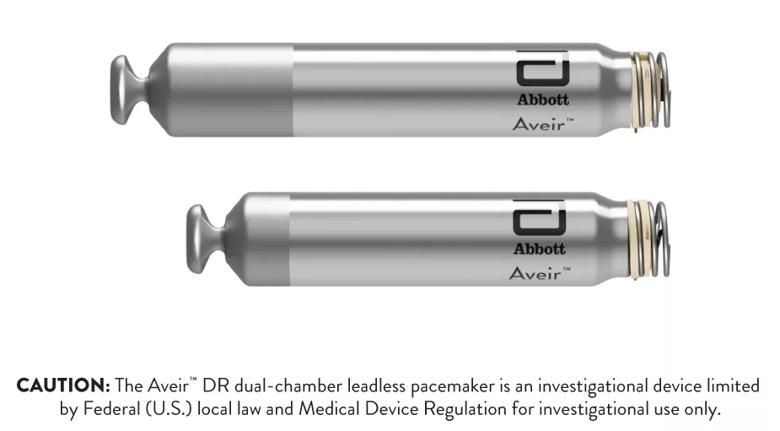Novel device provides pacing support to both the right atrium and right ventricle of the heart
images: 0
video: 0
audio: 0
text: 0

Cleveland Clinic has successfully implanted a dual-chamber leadless pacemaker system in the first patient in the United States as part of a global clinical trial, which aims to offer heart rhythm patients a more targeted approach through a less invasive procedure with fewer complications.
The leadless pacemaker system used in the trial includes two leadless pacemakers – one for the right ventricle and one for the right atrium. These two devices are designed to communicate with each other to provide beat-by-beat communication based on the patient’s needs.

Pacemakers are used to treat abnormally slow heart rhythm disorders, including sinus node dysfunction, which is the inability of the sinus node to create an appropriate heart rate. Pacemakers also treat heart block, which occurs when the electrical signals from the top chambers of the heart don’t conduct properly to the bottom chambers. Such arrhythmias, irregular or abnormal rhythms, can cause difficulty breathing, dizziness, fainting or even sudden cardiac death in some instances.
Traditional pacemakers require an incision to implant a power generator placed under the skin near the collarbone, which then connects to wires that are stretched through veins and attached to the heart muscle.
Unfortunately, studies have shown that up to one in six patients will experience a complication with this type of pacemaker over a three-year period, most commonly bleeding or infection in the surgical pocket or dislodgement, fracture or blood clots around the wires.
Leadless pacemakers are miniaturized devices implanted directly into the heart, and do not require wires or incisional access. Prior studies have shown fewer complications associated with leadless devices over several years. Cleveland Clinic implanted its first single-chamber leadless pacemaker in 2014. However, the single-chamber leadless pacemakers meet the needs of less than 10% of patients requiring pacing support, with the remainder requiring multi-chamber pacing.
“This has potential to offer patients requiring pacing support not only a less invasive option, but it also eliminates lead-related complications and possibly creates a more targeted approach,” says Daniel Cantillon, M.D., research director and associate section head of Cardiac Electrophysiology and Pacing in the Heart, Vascular & Thoracic Institute at Cleveland Clinic and clinical trial steering committee co-chair. “Until now, pacemakers have only been able to pace one chamber at a time. This new system allows electrical signals to be sent to both sets of the contracting muscles to help provide the needed pacing.”
Dr. Cantillon, a co-principal investigator of the study, reports financial interests with Abbott associated with speaking, consulting and service on scientific advisory boards.
Leadless devices are smaller and designed to be retrievable so the system can be replaced if needed. With the single-chamber leadless pacemaker, devices have to be exchanged after seven or eight years. They are removed with a catheter and replaced with a new device in the same minimally invasive procedure.
The multi-center pivotal study will enroll about 550 patients with abnormal heart rhythms at up to 80 sites worldwide. The study will evaluate the safety, performance and effectiveness of The Aveir™ leadless pacemaker system, developed by Abbott.
Cleveland Clinic is a nonprofit multispecialty academic medical center that integrates clinical and hospital care with research and education. Located in Cleveland, Ohio, it was founded in 1921 by four renowned physicians with a vision of providing outstanding patient care based upon the principles of cooperation, compassion and innovation. Cleveland Clinic has pioneered many medical breakthroughs, including coronary artery bypass surgery and the first face transplant in the United States. Cleveland Clinic is consistently recognized in the U.S. and throughout the world for its expertise and care. Among Cleveland Clinic’s 82,600 employees worldwide are more than 5,786 salaried physicians and researchers, and 20,700 registered nurses and advanced practice providers, representing 140 medical specialties and subspecialties. Cleveland Clinic is a 6,728-bed health system that includes a 173-acre main campus near downtown Cleveland, 23 hospitals, 280 outpatient facilities, including locations in northeast Ohio; Florida; Las Vegas, Nevada; Toronto, Canada; Abu Dhabi, UAE; and London, England. In 2024, there were 15.7 million outpatient encounters, 333,000 hospital admissions and observations, and 320,000 surgeries and procedures throughout Cleveland Clinic’s health system. Patients came for treatment from every state and 112 countries. Visit us at clevelandclinic.org. Follow us at x.com/CleClinicNews. News and resources are available at newsroom.clevelandclinic.org.
Editor’s Note: Cleveland Clinic News Service is available to provide broadcast-quality interviews and B-roll upon request.